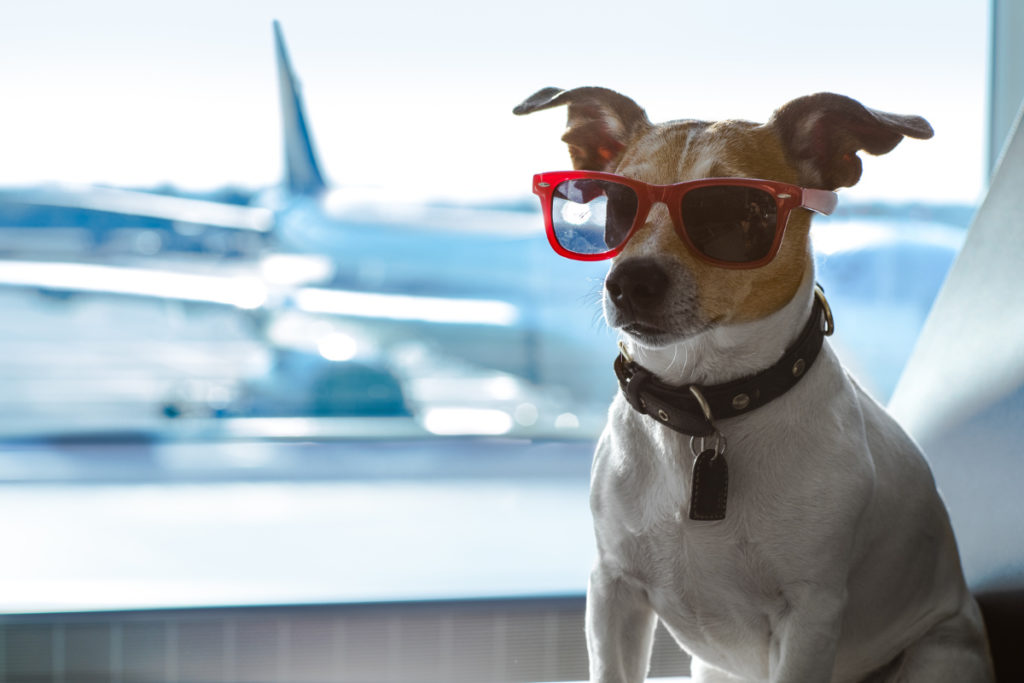9 most pet-friendly airlines in America
Signing up for credit cards through partner links earns us a commission. Terms apply to the offers listed on this page. Here’s our full advertising policy: How we make money.
Update: One or more card offers in this post are no longer available. Check our Hot Deals for the latest offers.
Flying by yourself can be a stressful experience for some people. Many people think that when you add a pet to the mix, it can lead to even more headaches! It’s why lots of travelers may opt for traveling on a train with their pet instead of flying.
But flying with your pet doesn’t have to be difficult, and there are plenty of airlines that go out of their way to make it a quick, easy process. Let’s look at what you can do to cut out any headaches or surprises when flying with your pet, and some of the best airlines to choose from. You can even get pet fees reimbursed if you have the right travel credit card!

Most pet-friendly U.S. airlines
- American Airlines: Best for West Coast travel
- United Airlines: Best for East Coast travel
- Delta Airlines: Best for small pets
- Southwest Airlines: Best for cheap pet fees
- JetBlue: Best for pet amenities
- Allegiant Air: Best for pet check-in process
- Frontier Airlines: Not really the best for anything
- Alaska Airlines: Best for unique pets in checked baggage
- Hawaiian Airlines: Best for inter-island flights in Hawaii
Comparing airline pet policies
| Airline | Price per pet | Allowed in the cabin? | Allowed in cargo? | Size restrictions |
| American Airlines | $125 | Yes | No, due to COVID-19 | All kennels: 19”x 13” x 9” |
| United Airlines | Cabin: $125 Cargo: Varies by weight | Yes | Yes | Hard kennels: 17.5” x 12” x 7.5” Soft kennels: 18” x 11” x 11” Cargo: No crates taller than 30” |
| Delta Airlines | $125 to/from US, Canada, Puerto Rico $75 to/from Brazil $200 Virgin Islands/International | Yes | No, due to COVID-19 | 21” x 15” x 16” |
| Southwest Airlines | $95 | Yes | No | 18.5” x 8.5” x 13.5” |
| JetBlue | $125 | Yes | No | 17” x 12.5” x 8.5” |
| Allegiant Air | $100 | Yes | No | 9” x 16” x 19” |
| Frontier Airlines | $99 | Yes | No | 10” x 16” x 24” |
| Alaska Airlines | $100 | Yes | Yes | Hard kennels: 17” x 11” 7.5” Soft kennels: 17” x 11” x 9.5” Cargo: 30” x 27” x 40” |
| Hawaiian Airlines | Cabin inter-island: $35 Cabin other flights: $175 Cargo inter-island: $60 Cargo other flights: $225 | Yes | Yes | Soft kennels: 16” x 10” x 9.5” Cargo: 36” x 24” x 26” or 40” x 27” x 30” depending on the aircraft |
Is flying safe for pets?
We’ve all seen the tragic headlines circulate every now and then talking about how a pet was injured during air travel. And while those accidents are truly unfortunate, it tends to paint the image that flying with a pet is dangerous.
This couldn’t be further from the truth! If you look at the statistics, it is actually VERY safe to fly with your pet. According to the Chicago Tribune, ~507,000 animals flew on U.S. commercial air carriers last year, and only 24 of those animals died while in transit. That’s only ~0.0048%! United Airlines has the highest rate of pet deaths, although it could be linked to the fact that until recently, they had allowed short-nosed breeds to fly. Now, with a new policy banning these breeds from flying on all airlines, the rate of pet injury should reduce significantly.
That said, there are still a few things you’ll want to keep in mind to make sure that you and your pet remain safe and comfortable during your flight.
Tips for pet safety while flying
For starters, certain breeds of dogs with short-snouts are not allowed to fly on planes because of respiratory issues that may make it particularly difficult for them to breathe. If you’re an owner of one of these breeds, you may want to consider traveling by train instead:
- Pug
- Bulldog
- French Bulldog
- Japanese Chin
- Neapolitan Mastiff
- Lhasa Apso
- Shih Tzu
- Pekingese
- Brussels Griffon
- Bullmastiff
- Affenpinscher
- English Toy Spaniel

You’ll also want to make sure that your dog is in good health, while also considering their age. Dogs who are too young or old may be particularly susceptible to the stresses of air travel because of things like changes in air quality, air circulation, temperature, cabin pressure, and other environmental issues.
If you’re worried about your pet’s health and don’t want them flying in checked luggage or cargo, double-check the requirements and restrictions with your airline to ensure your pet will be allowed to fly with you in the cabin and avoid any last-minute surprises at the airport.
Always be sure to consult with your vet before traveling (most airlines even require that you do!) to make sure your furry friend is ready to fly!
Best U.S. airlines for pet travel
Each airline has different policies for traveling with a pet, although almost all airlines require the carrier to allow your pet enough space to stand up, turn around, and lie down, and must fit underneath the seat. And if flying in checked luggage, the carrier should have proper ventilation on both sides.
Many airlines also restrict the number of pets flying in the cabin per flight, so you’ll want to follow each airline’s policy for reserving your pet’s spot. We’ve rounded up a list of some of the best airlines for traveling with a pet.
American Airlines
Types of pets allowed: Small pets at least 8 weeks old, and combined weight may not exceed 20 lbs.
More need-to-knows: Prior to your flight and as soon as you can, you’ll want to contact American Airlines customer service to reserve a spot for your pet. Pets flying with you in the cabin must remain in their carrier under the seat for the entire duration of the flight. Note that American Airlines does not allow pets to travel in the cabin if you are flying to/from Hawaii, Jamaica, Brazil, Chile, Uruguay, Argentina, Colombia, or on any transatlantic/transpacific flights.
United Airlines
Types of pets allowed: Cats and dogs
More need-to-knows: United Airlines only allows two dogs in the cabin for most of their flights, so you’ll want to call ahead as soon as you can to confirm your pet can travel with you. The pet carrier must fit completely under the seat. If your pet cannot fly with you in the cabin, you can use United Airlines’ pet transportation service, PetSafe. The airline has partnered with American Humane to improve their pet shipping processes, so it’s a very safe way of making sure your pet arrives at the destination safe and sound!
PetSafe is temporarily suspended.
Delta
Types of pets allowed: Dogs, cats, and household birds for domestic U.S. flights
More need-to-knows: Like many other airlines, Delta limits the number of animals that fly in coach, business class, and first class. So you’ll want to call and reserve your spot to ensure you can fly with your pet in the cabin. Pets are allowed to fly with you in the cabin as long as they remain in their carrier and can fit underneath your seat.
Southwest Airlines
Types of pets allowed: Small vaccinated dogs and cats on domestic flights only
More need-to-knows: Southwest allows a maximum of six pet carriers per flight on a first-come-first-served basis, so you’ll want to call and make your pet reservation as soon as you finalize your travel plans. Your pet carrier must be small enough to fit underneath the seat, and Southwest is one of the few airlines that does not require formal documentation for your pet to fly but does ask that they’re up-to-date on vaccines.
JetBlue
Types of pets allowed: Small dogs and cats are allowed
More need-to-knows: If you’re brand new to flying with a pet, you’ll be happy to know that JetBlue has an exclusive program called JetPaws, designed to give owners the tips and tools they need for a smooth trip with their pet. It’s a free program, and you’ll also earn 300 JetBlue points on each flight segment you fly with your pet!
JetBlue allows four pets per flight, so it’s important to book your flight and reserve your pet’s seat as soon as possible. You can call JetBlue and let the agent know you are traveling with a pet so that they can reserve your spot for the flight. Although exceptions may be made, generally speaking only one pet is allowed per person, and the pet carrier must fit underneath the seat.
If flying to or from Jamaica, the Cayman Islands, or St. Lucia, JetBlue says “You are urged to begin the import process at least 30 days prior to travel to prepare your dog or cat to travel.” Head to this page for the pertinent links.
Allegiant Air
Types of pets allowed: Cats and dogs if flying within the contiguous 48 U.S. states, San Juan, and Puerto Rico
More need-to-knows: If you’re looking for easy, hassle-free pet travel within the U.S., you can book a flight on Allegiant. They do not require any health certificates, and you can reserve your pet’s spot at the same time you book your own plane ticket online! In other words, there is no need to make a separate phone call for your pet.
Frontier Airlines
Types of pets allowed: Dogs and cats only in the cabin
More need-to-knows: While Frontier does not specifically require a health certificate for your pet, you may need one depending on the state you will be flying to. If you will be traveling internationally, however, you will definitely need a health certificate.
Alaska Airlines
Types of pets allowed: Dogs, cats (both at least eight weeks old), rabbits, and household birds in the cabin. Dogs, cats, ferrets, guinea pigs, hamsters, household birds, non-poisonous reptiles, pot bellied pigs, rabbits, and tropical fish as cargo.
More need-to-knows: If you have some unique pets but are not able to take them with you in the main cabin, Alaska Airlines is a great choice as they allow a wide variety of pets to fly in checked baggage. And with their Fur-st Class Care program, you’ll receive a notification confirming your pet has made it safely aboard the plane.
Otherwise, the first class cabin can only accommodate one pet, and the main cabin can accommodate five at most, so you’ll want to reserve your pet’s spot as soon as possible. Dogs and cats must be at least eight weeks old, and each passenger may travel with no more than two pets. And certain short-nosed animals may not be allowed to travel in cargo but may be permitted to travel in the cabin.
Hawaiian Airlines
Types of pets allowed: Small dogs and cats in the cabin and in cargo
More need-to-knows: As with other airlines, you’ll want to reserve a ticket for yourself and your pet as soon as your travel plans are finalized and you book your ticket. Each person can travel with one pet carrier. Pets are not accepted on international flights to or from New York-JFK, Boston, Orlando, or Austin. And certain short-nosed pets are not allowed to fly at all on Hawaiian Airlines.
How to prepare your pet for travel
Pets are like family and flying with them requires just as much preparation as flying with children! Once you know you’ll be traveling with your pet, try to schedule an appointment with their veterinarian about a week or so before your flight. Your veterinarian will be able to examine your pet and give them a travel health certificate so you’re sure your furry friend is all set to fly. Your pet will also need to be in a carrier the entire time you’re flying, so if they aren’t used to being in a crate, you might want to practice with them by putting them in for an hour or more each day leading up to the trip, especially if you’ll be on a long flight.
On the actual day of your flight, make sure your pet has all of the food, water and toys they need! Double-check you have all the necessary paperwork and get to the airport with extra time to make sure your pet is settled in before the flight.
Flying with a service dog
On most airlines, flying with a service animal is a little bit different than flying with a pet. If you want to bring a service dog on your flight, you’ll likely need to submit to the airline: a medical/mental health professional form verifying the need for a service dog, a veterinary health form showing your service dog is up to date on vaccinations and an animal behavior form. It’s best practice to submit these forms no later than 48 hours before your flight, but once they’re approved by the airline, you’ll be all set to bring your service dog on the flight. Typically, service dogs have no additional fee.
Additionally, most airlines require service dogs to be seated on the floor below your seat or in your lap, so be sure to book a seat that has enough room for your dog to fly comfortably and safely. Check your airline restrictions before booking, because some don’t allow service dogs in the exit row.
Flying with an emotional support animal
Registering an emotional support animal to fly is largely the same process as flying with a service dog. It depends on which airline you’re flying, but almost all require doctor authorization, vet documentation and an animal behavior form. With an emotional support animal, you’re responsible for making sure your pet doesn’t climb on the seats, relieve itself on the plane, and is overall under your control at all times.
Do note that all above airlines are no longer accepting emotional support animals.
FAQs about flying with pets
What is the safest airline for pets?
There isn’t just one airline safest for pets, there are just some that are better suited for some pets than others. It’s always the responsibility of the owner to ensure their pet is in good health to fly with a visit to the vet before the flight, but as long as your pet is given the all-clear, it’s up to you to decide the best airline.
Due to coronavirus, some airlines, like Delta and American, are not allowing pets as cargo. That means those airlines might not be best or safest for larger animals. JetBlue is best for pet amenities, so it might be best for a pet that likes to be spoiled. You know your pet best, and you’ll know what’s safest for them!
What documents do I need for my pet to fly?
For all pets: A certificate of veterinary inspection to travel and in some cases, an acclimation certificate which you can also get from your veterinarian.
For service animals: A certificate of approval from a medical/mental health professional, a veterinary inspection to travel and an animal behavior form.
What are some of the new airline pet restrictions after the pandemic?
Again, because of increased flight changes as a result of the pandemic, some airlines are not allowing pets as cargo. Besides this, most airlines have not changed their restrictions for pets much because of the pandemic, but it’s always good to double-check the airline website for the most up-to-date information before flying!
How to fly with your pet for free
All airlines charge some kind of fee for flying with a pet. But did you know that having the right travel credit card can get some (or all) of those fees waived?
A handful of credit cards offer an airline incidental credit or some other form of travel credit, replenished every single year you keep the card. Here’s an example of cards that will pay for your pet fees:
- The Platinum Card® from American Express: Up to $200 annual airline credit for incidental expenses (like pet fees) on your selected airline (enrollment required)
- The Business Platinum Card® from American Express: Up to $200 annual airline credit for incidental expenses (like pet fees) on your selected airline (enrollment required)
- Chase Sapphire Reserve®: Annual $300 credit to be used towards travel (should absolutely reimburse pet fees)
- Citi Prestige® Card: Annual $250 credit to be used towards travel (also should reimburse pet fees)
The information for the Citi Prestige has been collected independently by Million Mile Secrets. The card details on this page have not been reviewed or provided by the card issuer.
Editorial Note: We're the Million Mile Secrets team. And we're proud of our content, opinions and analysis, and of our reader's comments. These haven’t been reviewed, approved or endorsed by any of the airlines, hotels, or credit card issuers which we often write about. And that’s just how we like it! :)






Join the Discussion!